2014 Peugeot Boxer oil filter
[x] Cancel search: oil filterPage 15 of 240
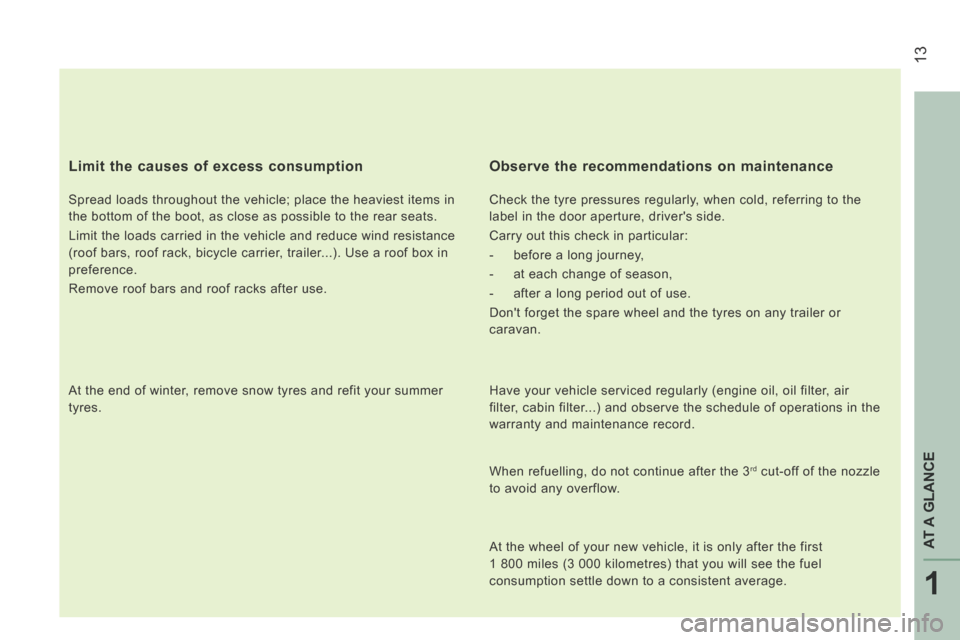
13
1
AT A GLANCE
Limit the causes of excess consumption
Spread loads throughout the vehicle; place the heaviest items in
the bottom of the boot, as close as possible to the rear seats.
Limit the loads carried in the vehicle and reduce wind resistance
(roof bars, roof rack, bicycle carrier, trailer...). Use a roof box in
preference.
Remove roof bars and roof racks after use.
At the end of winter, remove snow tyres and refit your summer
tyres.
Observe the recommendations on maintenance
Check the tyre pressures regularly, when cold, referring to the
label in the door aperture, driver's side.
Carry out this check in particular:
- before a long journey,
- at each change of season,
- after a long period out of use.
Don't forget the spare wheel and the tyres on any trailer or
caravan.
Have your vehicle serviced regularly (engine oil, oil filter, air
filter, cabin filter...) and observe the schedule of operations in the
warranty and maintenance record.
When refuelling, do not continue after the 3
rd cut-off of the nozzle
to avoid any overflow.
At the wheel of your new vehicle, it is only after the first
1 800 miles (3 000 kilometres) that you will see the fuel
consumption settle down to a consistent average.
Page 125 of 240
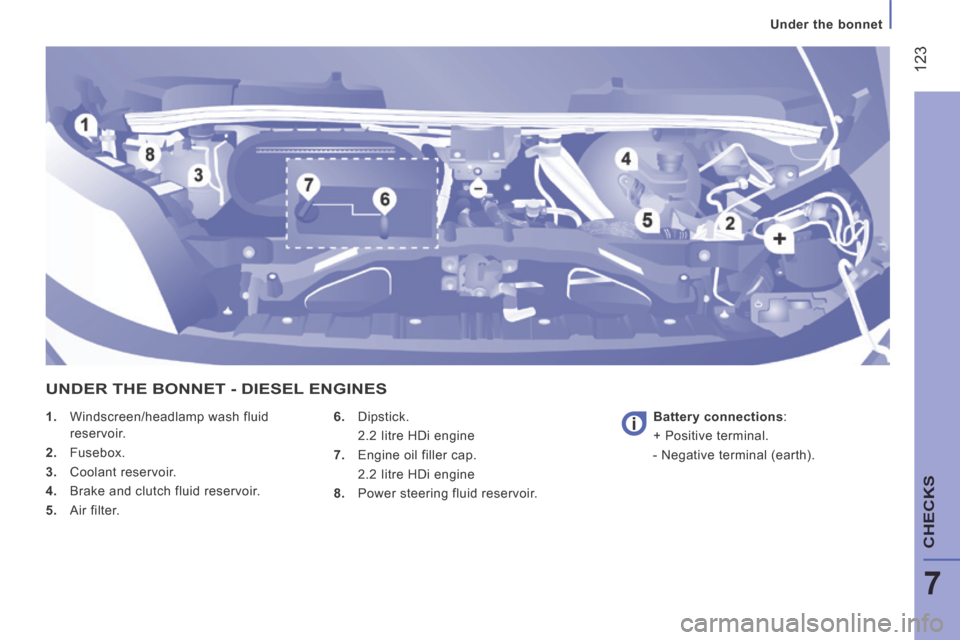
123
7
Under the bonnet
CHECKS
1. Windscreen/headlamp wash fluid reservoir.
2. Fusebox.
3. Coolant reservoir.
4. Brake and clutch fluid reservoir.
5. Air filter. 6. Dipstick.
2.2 Iitre HDi engine
7. Engine oil filler cap.
2.2 Iitre HDi engine
8. Power steering fluid reservoir.
Battery connections :
+ Positive terminal.
- Negative terminal (earth).
UNDER THE BONNET - DIESEL ENGINES
Page 128 of 240
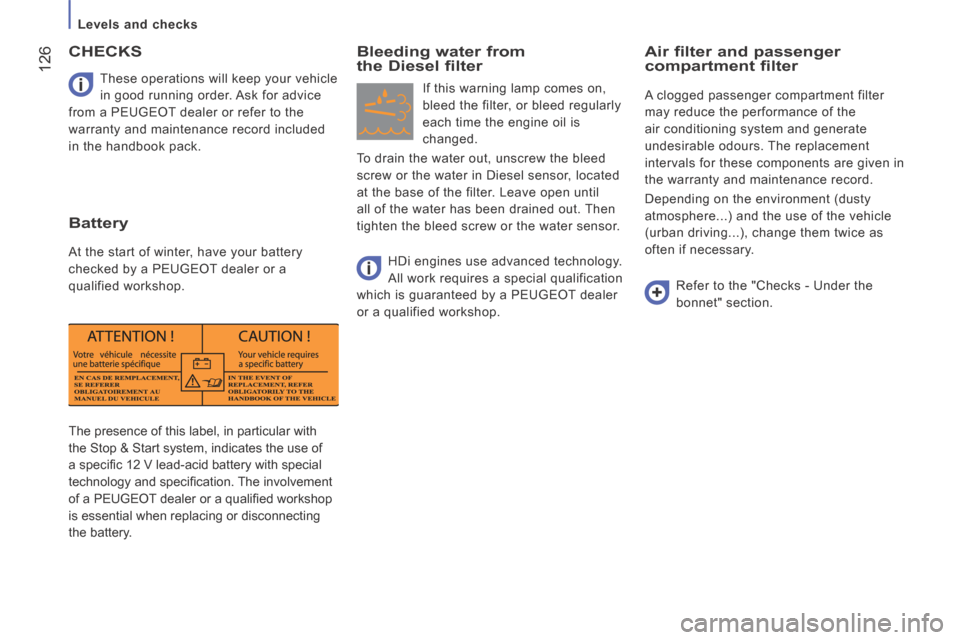
126
Levels and checks
The presence of this label, in particular with
the Stop & Start system, indicates the use of
a specifi c 12 V lead-acid battery with special
technology and specifi cation. The involvement
of a PEUGEOT dealer or a qualifi ed workshop
is essential when replacing or disconnecting
the battery. These operations will keep your vehicle
in good running order. Ask for advice
from a PEUGEOT dealer or refer to the
warranty and maintenance record included
in the handbook pack.
CHECKS
Battery
At the start of winter, have your battery
checked by a PEUGEOT dealer or a
qualified workshop.
Bleeding water from the Diesel filter
If this warning lamp comes on,
bleed the filter, or bleed regularly
each time the engine oil is
changed.
To drain the water out, unscrew the bleed
screw or the water in Diesel sensor, located
at the base of the filter. Leave open until
all of the water has been drained out. Then
tighten the bleed screw or the water sensor.
Air filter and passenger compartment filter
A clogged passenger compartment filter
may reduce the performance of the
air conditioning system and generate
undesirable odours. The replacement
intervals for these components are given in
the warranty and maintenance record.
Depending on the environment (dusty
atmosphere...) and the use of the vehicle
(urban driving...), change them twice as
often if necessary.
Refer to the "Checks - Under the
bonnet" section.
HDi engines use advanced technology.
All work requires a special qualification
which is guaranteed by a PEUGEOT dealer
or a qualified workshop.
Page 129 of 240
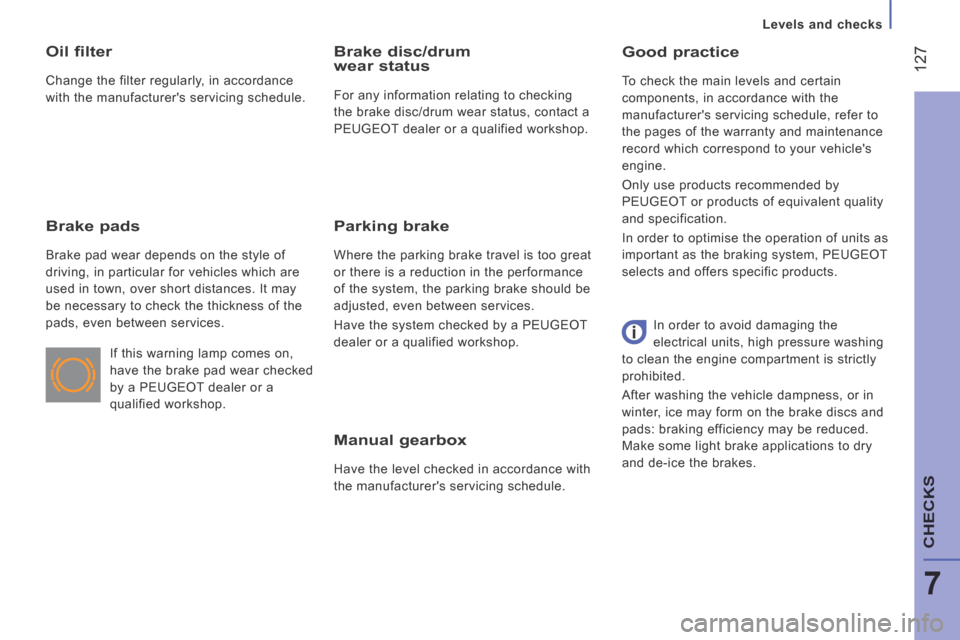
127
7
CHECKS
Levels and checks
Manual gearbox
Have the level checked in accordance with
the manufacturer's servicing schedule.
Good practice
To check the main levels and certain
components, in accordance with the
manufacturer's servicing schedule, refer to
the pages of the warranty and maintenance
record which correspond to your vehicle's
engine.
Only use products recommended by
PEUGEOT or products of equivalent quality
and specification.
In order to optimise the operation of units as
important as the braking system, PEUGEOT
selects and offers specific products.
Oil filter
Change the filter regularly, in accordance
with the manufacturer's servicing schedule.
Brake pads
Brake pad wear depends on the style of
driving, in particular for vehicles which are
used in town, over short distances. It may
be necessary to check the thickness of the
pads, even between services.
Brake disc/drum wear status
For any information relating to checking
the brake disc/drum wear status, contact a
PEUGEOT dealer or a qualified workshop.
Parking brake
Where the parking brake travel is too great
or there is a reduction in the performance
of the system, the parking brake should be
adjusted, even between services.
Have the system checked by a PEUGEOT
dealer or a qualified workshop.
If this warning lamp comes on,
have the brake pad wear checked
by a PEUGEOT dealer or a
qualified workshop. In order to avoid damaging the
electrical units, high pressure washing
to clean the engine compartment is strictly
prohibited.
After washing the vehicle dampness, or in
winter, ice may form on the brake discs and
pads: braking efficiency may be reduced.
Make some light brake applications to dry
and de-ice the brakes.
Page 130 of 240
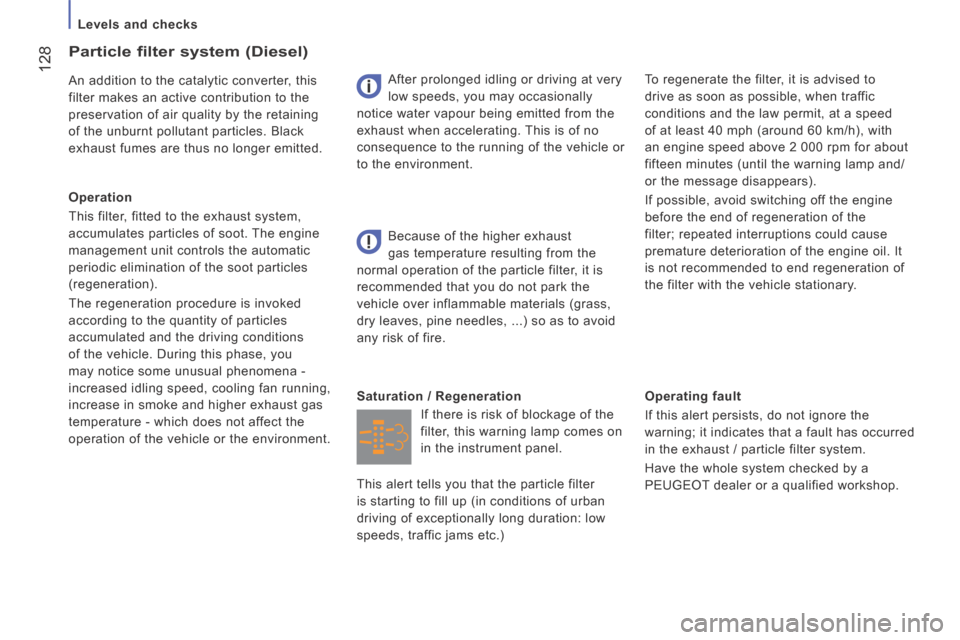
128
Levels and checks
Operating fault
If this alert persists, do not ignore the
warning; it indicates that a fault has occurred
in the exhaust / particle filter system.
Have the whole system checked by a
PEUGEOT dealer or a qualified workshop.
If there is risk of blockage of the
filter, this warning lamp comes on
in the instrument panel.
Saturation / Regeneration Because of the higher exhaust
gas temperature resulting from the
normal operation of the particle filter, it is
recommended that you do not park the
vehicle over inflammable materials (grass,
dry leaves, pine needles, ...) so as to avoid
any risk of fire.
Particle filter system (Diesel)
An addition to the catalytic converter, this
filter makes an active contribution to the
preservation of air quality by the retaining
of the unburnt pollutant particles. Black
exhaust fumes are thus no longer emitted.
Operation
This filter, fitted to the exhaust system,
accumulates particles of soot. The engine
management unit controls the automatic
periodic elimination of the soot particles
(regeneration).
The regeneration procedure is invoked
according to the quantity of particles
accumulated and the driving conditions
of the vehicle. During this phase, you
may notice some unusual phenomena -
increased idling speed, cooling fan running,
increase in smoke and higher exhaust gas
temperature - which does not affect the
operation of the vehicle or the environment. After prolonged idling or driving at very
low speeds, you may occasionally
notice water vapour being emitted from the
exhaust when accelerating. This is of no
consequence to the running of the vehicle or
to the environment. To regenerate the filter, it is advised to
drive as soon as possible, when traffic
conditions and the law permit, at a speed
of at least 40 mph (around 60 km/h), with
an engine speed above 2 000 rpm for about
fifteen minutes (until the warning lamp and/
or the message disappears).
If possible, avoid switching off the engine
before the end of regeneration of the
filter; repeated interruptions could cause
premature deterioration of the engine oil. It
is not recommended to end regeneration of
the filter with the vehicle stationary.
This alert tells you that the particle filter
is starting to fill up (in conditions of urban
driving of exceptionally long duration: low
speeds, traffic jams etc.)
Page 161 of 240
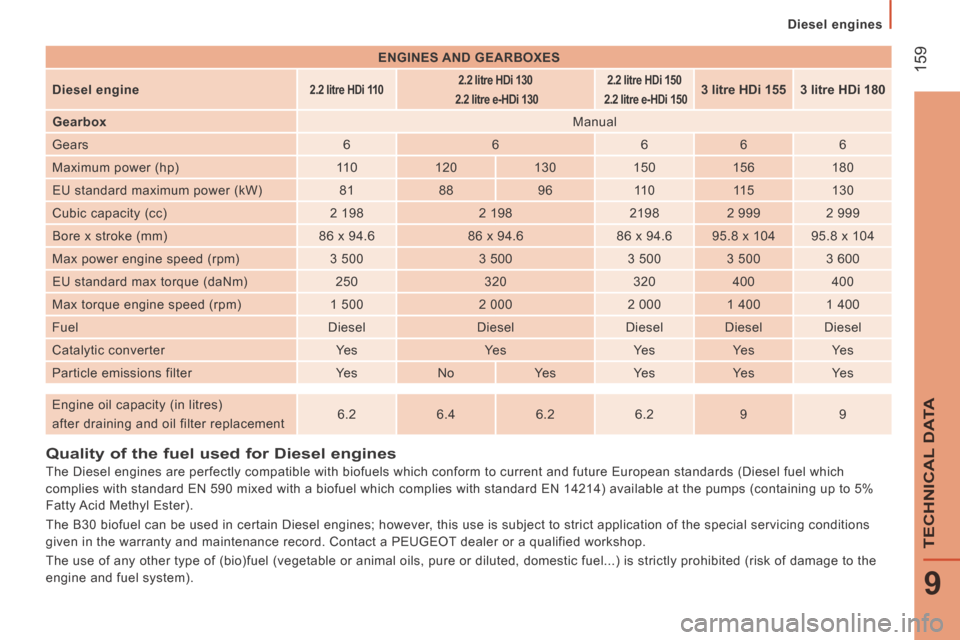
159
9
TECHNICAL DATA
Diesel engines
Quality of the fuel used for Diesel engines
The Diesel engines are perfectly compatible with biofuels which conform \
to current and future European standards (Diesel fuel which
complies with standard EN 590 mixed with a biofuel which complies with s\
tandard EN 14214) available at the pumps (containing up to 5%
Fatty Acid Methyl Ester).
The B30 biofuel can be used in certain Diesel engines; however, this use is subject to strict application of the special servicing con\
ditions
given in the warranty and maintenance record. Contact a PEUGEOT dealer or a qualified workshop.
The use of any other type of (bio)fuel (vegetable or animal oils, pur\
e or diluted, domestic fuel...) is strictly prohibited (risk of damage to the
engine and fuel system). ENGINES AND GEARBOXES
Diesel engine
2.2 litre HDi 110 2 .2 litre HDi 13 0
2.2 litre e-HDi 130 2 .2 litre HDi 150
2.2 litre e-HDi 150 3 litre HDi 155 3 litre HDi 180
Gearbox Manual
Gears 6 6 6 6 6
Maximum power (hp) 11 0 120 130 150 156 180
EU standard maximum power (kW) 81 88 96 11 0 11 5 130
Cubic capacity (cc) 2 198 2 198 2198 2 999 2 999
Bore x stroke (mm) 86 x 94.6 86 x 94.6 86 x 94.6 95.8 x 104 95.8 x 104
Max power engine speed (rpm) 3 500 3 500 3 500 3 500 3 600
EU standard max torque (daNm) 250 320 320 400 400
Max torque engine speed (rpm) 1 500 2 000 2 000 1 400 1 400
Fuel Diesel Diesel Diesel Diesel Diesel
Catalytic converter Ye s Ye s Ye s Ye s Ye s
Particle emissions filter Ye s No Ye s Ye s Ye s Ye s
Engine oil capacity (in litres)
after draining and oil filter replacement 6.2
6.4 6.2 6.2 9 9